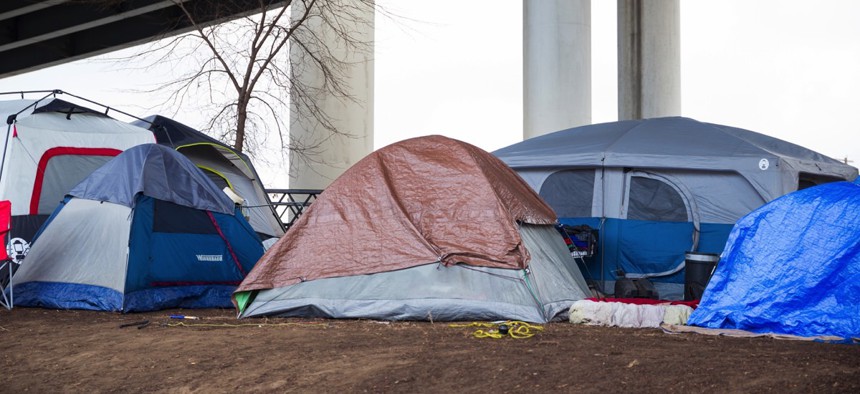Mayors Share Experiences From Their Efforts to End Veteran Homelessness


Connecting state and local government leaders
At the U.S. Conference of Mayors winter meeting in the nation’s capital, Austin’s Steve Adler and John Giles of Mesa, Ariz., discuss their power to convene.
WASHINGTON — Real progress has been made in the last six years in the fight to end homelessness.
Between 2010 and 2016, there was a 14 percent reduction in overall homelessness nationwide, according to a new report by the United States Interagency Council on Homelessness presented on Tuesday at the 85th Winter Meeting of the United States Conference of Mayors in the nation’s capital.
In that same period of time, the U.S. saw a 27 percent reduction in chronic homelessness, and a 27 percent decrease in family homelessness—including a 65 percent drop in the population of homeless families who aren’t being served by shelter systems.
Perhaps the most impressive figures come in the realm of veteran homelessness. From 2010 to 2016, the U.S. saw the number of homeless veterans drop by an astounding 47 percent. And, in that time, 35 communities and three states—Virginia, Connecticut and Delaware—have “effectively ended” homelessness.
Speaking on a panel on hunger and homelessness, Matthew Doherty, the executive director of USICH, credited that progress to a few major changes, both in policy, and in overall community attitudes.
According to Doherty, in the past five years, there has been an existential shift in the way people who deal with the issue of homelessness think about the order of their work. The conventional wisdom once stated that a person must be connected to social services systems before the issue of housing can be addressed. Now, the reverse is understood to be true.
The shift towards housing-first policies—making stable housing the number one priority—increases a person’s ability to successfully engage with vital services like job training, mental health counseling or drug treatment.
In the past five years, there has also been a new national emphasis not just on setting ambitious goals and urgent deadlines, but also in empowering a crucial ally in this fight—mayors. The Mayors Challenge, which was rolled out by first lady Michelle Obama in June 2014 with the goal of ending veteran homelessness by 2015, was one such initiative, and it’s one of the reasons leaders like Mayors Steve Adler of Austin, Texas, and John Giles of Mesa, Arizona, were part of Tuesday’s conversation.
Austin and Mesa are two of the communities that have functionally brought an end to veteran homelessness in their localities. Both Adler and Giles see a certain power that comes with their titles that made them uniquely capable of solving this problem—that’s the power to convene.
When Adler met with resistance from recalcitrant landlords who found it far too risky to consider renting to people with no fixed address and unsteady income—some of whom also had criminal records—he found the best thing to do was to get everyone into one room for productive dialogue. Adler set up a meeting with people with access to homes, people looking for homes, apartments association, the real estate council, members of the business community and representatives from critical social services systems.
In his words, “everyone that was needed to solve the homelessness challenge was in that room.”
Out of that meeting, Adler learned that landlords were still too nervous to rent to this population. That piece of information allowed him to arrive at a critical aspect of the homelessness protocol in Austin. The city raised money—acting in many ways like a non-profit organization with a core funder base—and established a pool of money to set landlords’ minds at ease.
Now, in the (very rare) event that a previously homeless tenant damages an apartment, a landlord is able to file a request for funds from City Hall and Adler happily bragged that they get their check within that same day. Those multi-stakeholder meetings also brought about a system in which participating landlords are connected with social services which are on-call 24 hours-a-day to help them with whatever issues may arise.
In all, it took Austin a year and a half to reach effective zero in veteran homelessness. Now they’re using what they’ve learned to tackle youth homelessness. Adler said his city plans to move one cohort at a time until they reach an end to homelessness altogether.
In this time of presidential transition in Washington, D.C., many officials in the room on Tuesday appeared hopeful that the progress on homelessness would continue into the future administration—after all, there is much work to be done.
Giles, a Republican official in a very red region admitted that, in his time in the job, he has often wondered how many of the valuable initiatives coming out of the Obama White House would be embraced by his community. As someone who doesn’t identify as a very “partisan” person, he was worried that if he took these programs to Mesa, he’d be strongly opposed simply because they bore the White House seal. Veteran homelessness, however was one issue he knew his town would embrace.
He urged those in the room who find themselves in a similarly politically charged environment to take up this issue, regardless of party background.
Doherty echoed that optimism for the future of anti-homelessness work.
“The drive to end homelessness didn’t start with this administration, and it doesn’t have to end [with the inauguration] on Friday.”
Quinn Libson is a Staff Correspondent for Government Executive’s Route Fifty based in Washington, D.C.

NEXT STORY: For U.S. Conference of Mayors, ‘So Far, So Good’ With Trump





